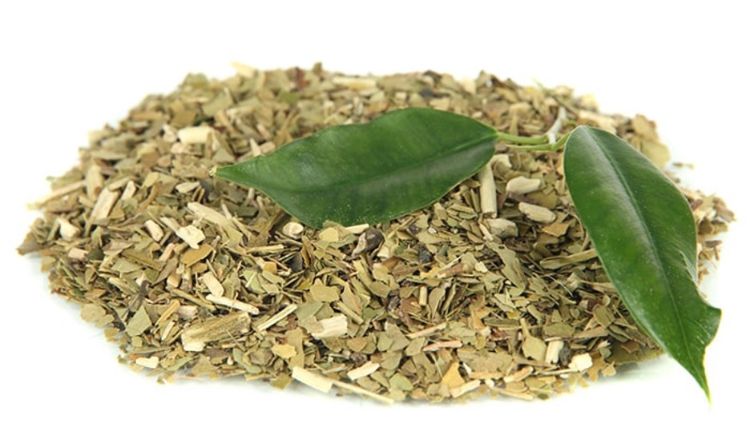BACKGROUND
Ingredient Type: Botanical
Also Known As: Maté, Ilex paraguariensis, Brazilian-tea, Paraguay tea

Yerba mate is a type of holly tree that grows in the rainforests of South America. Traditionally, Yerba mate drinks are served in a gourd and are sipped through a metal straw (a “bombilla”) which separates the tea from the leaves.
Research has found that it may improve allergy symptoms and reduce blood sugar levels. Mate also contains compounds that are believed to act as an appetite suppressant, increase mental energy and focus, improve mood, and promote deeper sleep.
Yerba mate leaf is an herb prepared as a traditional beverage consumed mainly in the South American countries of Argentina, Uruguay, Brazil, and Paraguay. Yerba mate is also consumed in the Middle East (Syria and Lebanon), due to the number of Arab emigrants from South America.
Yerba mate was supposedly first cultivated by the Guarani people of South America (1). A traditional legend exists that says that Goddesses of the Moon and Cloud came to earth and were attacked by a kind of jaguar. An old man saved them and he was given a new plant from which a “drink of friendship” could be prepared. Jesuit missionaries may have been the first Europeans to use yerba mate.
TRADITIONAL USES
Yerba Mate is used in supplements today for its energizing and antioxidant benefits. Orally, yerba mate is used as a stimulant to relieve mental and physical fatigue. It’s also used as a diuretic, for modifying mood or affective disorders, as a mild analgesic for headache and rheumatic pains, and as a laxative in large amounts. It is also used orally for depression, weight loss, urinary tract infections (UTIs), chronic fatigue syndrome (CFS), cardiac insufficiency, arrhythmias, hypotension, nervous heart complaints, kidney and bladder stones, and to promote cleansing and excretion of waste.
WHAT DOES SCIENCE TELL US?
Neurological effects: In animal research, Ilex paraguariensis protected against haloperidol-induced orofacial dyskinesia and memory dysfunction; antioxidant effects were implicated (4). In animal research, the hydroalcoholic extract of mate tea leaves improved short-term social memory and facilitated the step-down inhibitory avoidance short-term memory (5).
Respiratory effects: In animal research, mate tea reduced acute lung inflammation following exposure to cigarette smoke (6). Alveolar macrophages and neutrophils in bronchoalveolar lavage were reduced, as was lipid peroxidation, tumor necrosis factor-alpha, and matrix metalloprotease-9 activity.
Mechanism of action: Ilex paraguariensis contains constituents xanthines,(alkaloids in the same family as caffeine), theophylline, and theobromine, (stimulants also found in coffee and chocolate).potassium, magnesium and manganese. These chemicals are stimulants. Containing 196 active compounds, nutrients, and amino acids, Yerba maté is rich in phenolics and saponins with potential lipid-lowering properties and has shown favorable results in a study showing drinking green and roasted yerba maté over time has cholesterol-lowering potential. Mate contains an alkaloid called mateine, which acts much like smooth caffeine.
SAFETY
Yerba mate is not likely to pose dangers for adults who drink it in moderation and are otherwise healthy, according to the Mayo Clinic. Toxicology of Yerba mate is predominantly theoretical and based on the adverse effect profile of caffeine.
REFERENCES
- Bracesco, N., Sanchez, A. G., Contreras, V., Menini, T., and Gugliucci, A. Recent advances on Ilex paraguariensis research: Minireview. J Ethnopharmacol. 6-26-2010;
- Nestle, N., Pauls, S., and Wunderlich, A. Oral magnetic resonance imaging contrast agent based on Ilex paraguayensis herbal extract. Magn Reson.Med. 2006;55(4):923-929.
- Meyer, K. and Ball, P. Psychological and Cardiovascular Effects of Guarana and Yerba Mate: A Comparison with Coffee. Revista Interamericana de Psicologia 2004;38(1):87-94
- Colpo, G., Trevisol, F., Teixeira, A. M., Fachinetto, R., Pereira, R. P., Athayde, M. L., Rocha, J. B., and Burger, M. E. Ilex paraguariensis has antioxidant potential and attenuates haloperidol-induced orofacial dyskinesia and memory dysfunction in rats. Neurotox.Res 2007;12(3):171-180
- Prediger, R. D., Fernandes, M. S., Rial, D., Wopereis, S., Pereira, V. S., Bosse, T. S., Da Silva, C. B., Carradore, R. S., Machado, M. S., Cechinel-Filho, V., and Costa-Campos, L. Effects of acute administration of the hydroalcoholic extract of mate tea leaves (Ilex paraguariensis) in animal models of learning and memory. J Ethnopharmacol. 12-8-2008;120(3):465-473.
- Lanzetti, M., Bezerra, F. S., Romana-Souza, B., Brando-Lima, A. C., Koatz, V. L., Porto, L. C., and Valenca, S. S. Mate tea reduced acute lung inflammation in mice exposed to cigarette smoke. Nutrition 2008;24(4):375-381
See the MedlinePlus entry for yerba mate, the Examine.com entry for yerba mate, the WebMD entry for yerba mate, the RXList entry for maté, or this European Medicines Agency monograph on Ilex paraguariensis for more information.









